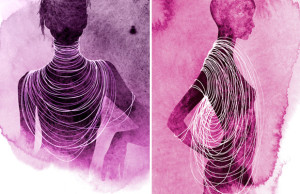Double Mitzvah – Terumah

Written by Maya B. Alma. Maya B. Alma is Jewrotica’s new Double Mitzvah columnist!
Check out last week’s column, Double Mitzvah – Mishpatim.
 This week’s parashah, Terumah, is an opportunity to revisit a theme we explored in my first column for Jewrotica. Reflecting on God’s assessment of isolation (“it is not good for humans to be alone”), and the stance of the woman as “helper across from” the man, I wrote:
This week’s parashah, Terumah, is an opportunity to revisit a theme we explored in my first column for Jewrotica. Reflecting on God’s assessment of isolation (“it is not good for humans to be alone”), and the stance of the woman as “helper across from” the man, I wrote:
Whatever form our relationships take, may we be blessed to have ezrim k’negdeinu, “helpful people across from us,” caring about our hearts and souls, hold us with love and concern even as they challenge us to become the very best versions of ourselves.
Our parashah this Shabbat, and the ones which follow for the next few weeks, deal with the building of the Mishkan, the Tabernacle. This dwelling-place for God (the root of the word mishkan is related to the term Shekhinah, the divine mothering Presence) is described in precise terms, and is pregnant with symbolism. Consider the kaporet, the cover for the Holy Ark (in which the tablets of the covenant were placed).
You shall make a cover of pure gold, two and a half cubits long and a cubit and a half wide. Make two cherubim of gold — make them of hammered work — at the two ends of the cover. Make one cherub at one end and the other cherub at the other end; of one piece with the cover shall you make the cherubim at its two ends. The cherubim shall have their wings spread out above, shielding the cover with their wings. They shall confront each other, the faces of the cherubim being turned toward the cover. Place the cover on top of the Ark, after depositing inside the Ark the Pact that I will give you. There I will meet with you, and I will impart to you — from above the cover, from between the two cherubim that are on top of the Ark of the Pact — all that I will command you concerning the Israelite people (Exodus 25:17-21).
Reading that passage with an eye toward the symbolism of the cherubim, a few things are noteworthy:
*at their root, the cherubim are “of one piece;”
*the cherubim are ready to soar, their wings spread;
*the cherubim are facing (“confronting”) one another (like those first two human beings back in Parashat Bereishit);
*God speaks to the people from the space between them.
The cherubim were gold-hammered representations of divine beings, but they were meant to teach about how to turn toward each other. We acknowledge that, at a deep level, we are one. We also respect and honor the space between us. We encourage each other to fly. And, when we are at our best, God enters the space between us.
There is a midrash that takes the image and really runs with it. Rabbi Jill Hammer writes compellingly about that midrash, in the collection Torah Queeries: Weekly Commentaries on the Hebrew Bible:
The Talmud conceives the cherubim as two beings locked in sexual embrace. Relying on an old tradition, the Talmud claims that on Shavuot, the anniversary of the day Torah was given to Israel, the people would gather in Jerusalem and the priests would open the Holy of Holies and reveal to them the two cherubim in sexual embrace: “When Israel used to make pilgrimage, they would roll up for them the veil and show them the cherubim which were entwined with one another, and say to them: behold, the love of God for you is like the love of male and female” (Yoma 54). According to this midrash, God rests not only in heart-wisdom but in the embrace of two bodies. There, too, the Shekhinah reveals Herself. And lest we think that holiness can reside only in the union of a man and a woman, we should note that although some midrashim imagine one cherub as male and one as female, most midrashim do not. In fact, the Torah text itself seems to ordain that both cherubim be made the same. The embrace of the cherubim is less about gender than it is about intimacy and love. At the core of holiness is the wisdom of love (p. 116).
May our relationships bear these gifts: a sense of deep connection, balanced with spaciousness; the freedom and courage to soar; a sense of the divine presence; and — especially on Shabbat, the day of the Double-Mitzvah — a joyous embrace!
Shabbat Shalom.












Pingback: Double Mitzvah – Tetzaveh – Jewrotica